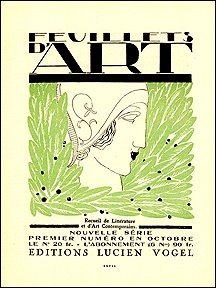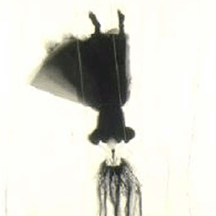The early twentieth century was an astounding period of change in fashion. The most dramatic change was the revisioning of the shape of a woman's body: from an extreme S-curve hightened by bustles and corsets to the languid cursive "I" that draped loosely but close to the body.
 Portrait of Mrs. George Gribble [Norah], 1888, painting by John Singer Sargent
Portrait of Mrs. George Gribble [Norah], 1888, painting by John Singer SargentPeggy Guggenheim [in a gown by Paul Poiret] 1924 photograph by Man Ray
Within just a few years the body lengthened, the curves were softened, if not completely flattened, the draping loosened, the heaviness of the fabric lightened and layers of fabric were reduced to a minumum.
Paul Iribe Les Robes de Paul Poiret (1909)
two paintings
Changes in fashion accompanied changes in the aesthetics of fine artists such as painters. The two portraits below are of very similiar subject matter: the meditative girl or young woman just on the brink of adulthood, are dressed in simple white dresses, representing their innocence and virginity.
Jeanne Hbuterne, Left Arm Behind her Head , 1919 , A. Modigliani, Barnes Foundation,
However the dress on the left clearly has many layers of ruffles and petticoats and is designed to emphasize the fullness of the body and to call attention to the bust and waist. The dress on the right also has a waist but it is barely noticeable. The dress falls straight in order to call attention to the length of the line. The rich luminous color of the Henri painting also contrasts with Modigliani's spare, stark coloring. The softness in color accentuates the softness of the figure and her relaxed body with only the hint of movement in her hands. Modigliani mannerist figure is in the midst of an active movement, stretching and twisting her body in a way that is sharp and awkward.
ancient greece
First time (in the western world) since ancient Greece fabric was draped on a woman's body in a way that did not hide or alter her shape. It is not surprising therefore that many of the designers were inspired by the styles in ancient Greek art.
ancient greece
First time (in the western world) since ancient Greece fabric was draped on a woman's body in a way that did not hide or alter her shape. It is not surprising therefore that many of the designers were inspired by the styles in ancient Greek art.
Left: Running Girl, Peloponnesian. British Museum.
Right: 1921 cover of Vanity Fair.
Right: 1921 cover of Vanity Fair.
While none of these images (above) are exclusively trying to depict an accurate physical recreation of a women's body (which is neither the extreme curves of the S or the straight line of the I). Art works convey more than factual information: their complexity of meanings can also put the fashions into wider social and aesthetic contexts.
Fashion is, after all, about the adornment of the body not its stripping. Nonetheless, it is fair to say that there was a significant change in the style of dress for women during the early decades of the twentieth century and the new styles generally made the body more visible and less constrained. The reasons for this change were varied -- all fashion changes have a certain element of whimsy -- but the radical alteration in line and architecture signals that designers were making clothes for a very different type of woman.






No comments:
Post a Comment